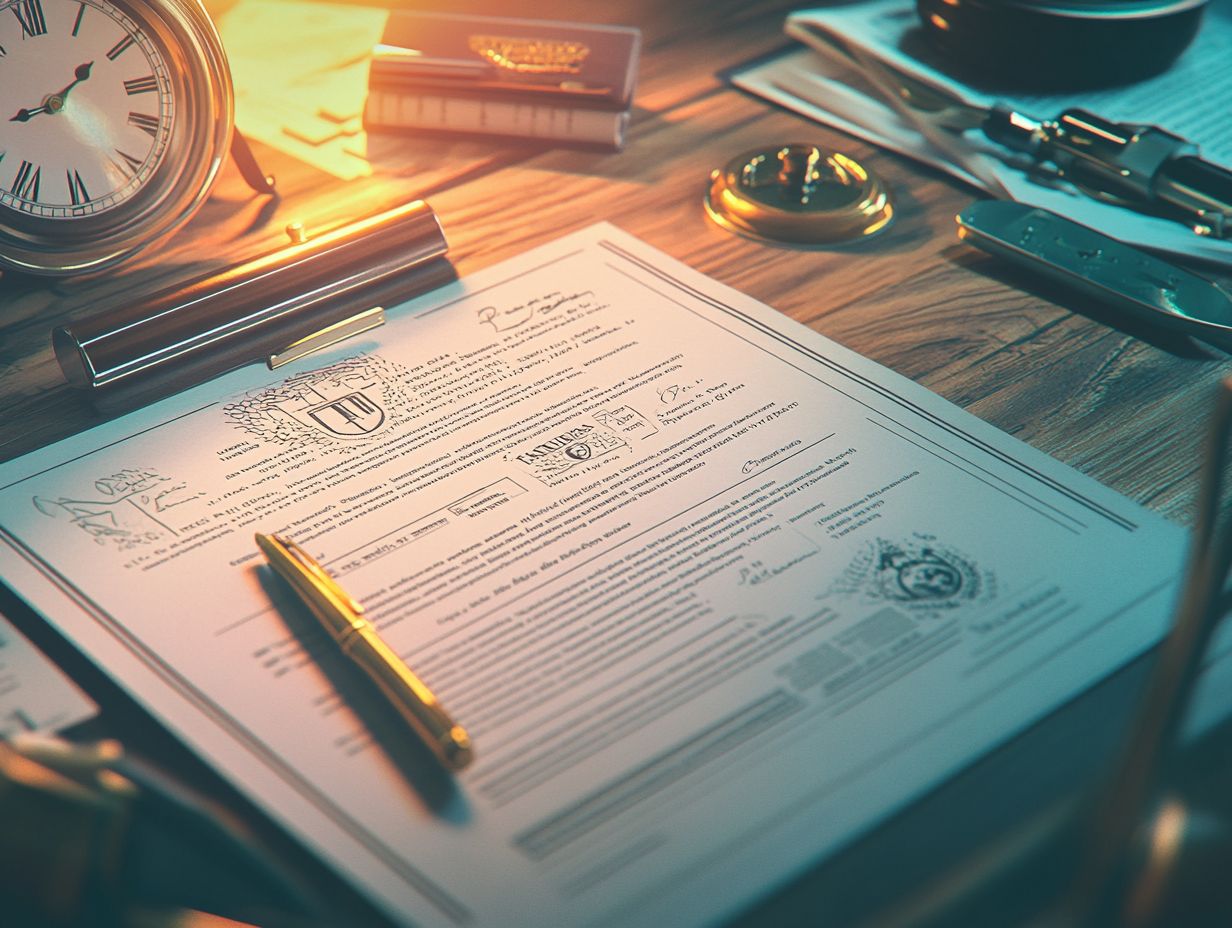The Lifespan of a Trademark: What You Need to Know
Trademarks are invaluable assets for your business. They serve as distinctive markers that enable consumers to differentiate between your products and services.
Understanding trademarks and recognizing the importance of protecting them is vital for your brand’s success.
This article explores the lifespan of a trademark, including how long protection lasts, the renewal process, and the factors that can influence a trademark’s validity.
You will also discover best practices for managing and safeguarding these essential elements of your brand.
Keep reading to ensure your trademark remains a strong component of your business identity.
Contents
Key Takeaways:

Trademarks are symbols, names, or phrases that identify and distinguish goods or services in the market.
Properly protecting and renewing a trademark can ensure its lifespan as long as it is actively used in commerce.
Changes in business operations, legal challenges, and infringement can affect the lifespan of a trademark, making it crucial to manage and protect it actively.
Understanding Trademarks
Understanding trademarks is essential for business owners or entrepreneurs who want to protect their brand value.
A trademark acts as a unique identifier, signifying the origin of your goods or services and helping you stand out in a competitive marketplace.
In the United States, you can register trademarks with the United States Patent and Trademark Office (USPTO), the government office that handles trademark registrations. This provides federal protection and the ability to enforce your rights against infringement.
Navigating the registration process, which includes necessary documentation and legal requirements, is crucial for securing your rights and maintaining your trademark’s status over time.
What is a Trademark?
A trademark is a distinctive sign, design, or expression that sets your products or services apart from others.
Trademarks come in various forms, including word marks, logos, mascots, and slogans, each serving a unique purpose in the marketplace.
Word marks are names or phrases that give your business a memorable identity, making it easy for consumers to recall you. Logos enhance visual recognition and can convey your brand’s essence instantly. Slogans are catchy phrases that capture your brand’s promise or mission, resonating emotionally with your audience.
Securing legal protection for these trademarks is vital. It enables you to defend against unauthorized use that could dilute your brand identity and helps maintain consumer trust and brand loyalty.
Importance of Trademark Protection
Trademark protection is crucial for business owners, providing legal rights and tools to prevent unauthorized use of your brand identity.
By securing these rights, you can cultivate a distinctive brand that stands out in the marketplace, leading to increased brand recognition.
This recognition fosters consumer trust, as customers associate your trademarked brand with quality and reliability.
Not having trademark protection can lead to costly infringements, where competitors exploit your hard-earned reputation, damaging its value and diluting its identity.
Without sufficient protection, you risk losing your rights, facing potential legal battles, and jeopardizing your competitive edge in the industry.
The Lifespan of a Trademark
Understanding the lifespan of a trademark is vital for any business owner. It outlines how long you can hold exclusive rights to your brand identity and prevent unauthorized use, making it important to be aware of trademark renewal requirements.
In the United States, once you register a trademark with the USPTO, it can last indefinitely, as long as you meet certain maintenance requirements.
This includes filing renewal documents on time and providing proof of ongoing use in commerce. Failing to meet these obligations could lead to cancellation or expiration of your trademark, allowing others to use your brand without consequences.
Take action today to protect your trademark and ensure it remains a strong asset for your business!
Duration of Trademark Protection

Trademark protection in the United States can last indefinitely if you actively use and maintain your trademark. To ensure ongoing protection, you need to follow specific timelines for trademark registration and renewal.
You can register a trademark for ten years. This isn t a one-time deal. To maintain your official trademark protection recognized by the federal government, you must file for renewal between the fifth and sixth years after your initial registration and then every ten years thereafter.
Your careful management ensures that your trademark rights remain intact, granting you exclusive use of your trademark within the United States, as long as you meet the necessary conditions.
Renewing and Maintaining a Trademark
Renewing and maintaining your trademark is crucial for enjoying strong protection and enforcing the rights tied to your brand.
Stay updated on renewal deadlines to protect your brand! The deadlines for filing your renewal applications can differ based on your jurisdiction. Typically, you’ll need to complete this process within a designated timeframe before your trademark registration expires.
To safeguard your brand, submit various documents as proof of use. This may include sales records, advertising materials, or samples of the product featuring your trademark.
Failure to meet these requirements can lead to severe consequences, including the loss of your trademark rights and the inability to stop others from using a similar mark. This could cause brand dilution and confusion in the marketplace, jeopardizing the identity you ve worked hard to establish.
Factors Affecting the Lifespan of a Trademark
Numerous factors can influence the lifespan of a trademark, including changes in the business landscape, shifts in brand identity, and potential legal challenges.
Changes in Business or Brand
Changes in your business operations or brand identity can significantly impact the protection and status of your trademark. When you shift your strategies, rebrand, or explore new markets, revisit your trademark filings and compliance documents.
These adjustments ensure that your trademark remains relevant and legally protected, allowing it to adapt to the ever-evolving business landscape. Continuing to use your trademark commercially solidifies its status and strengthens brand loyalty among consumers.
Remain vigilant, as any lapse in proper filing or usage could lead to challenges that may erode your hard-earned market presence and jeopardize your intellectual property rights.
Legal Challenges and Infringement
Legal challenges, such as trademark infringement disputes, can threaten the longevity and enforceability of your trademark. These challenges can take various forms, from costly infringement lawsuits that deplete your resources to emotional strain from opposition proceedings initiated by competitors.
Navigating these complexities requires a solid grasp of intellectual property law and the importance of proactive measures. Regularly monitor for potential infringements and act swiftly against misuse to preserve your rights.
By staying vigilant, you reinforce your brand integrity, deter unauthorized use, and ensure that your trademark remains a valuable asset in the competitive marketplace.
Managing the Lifespan of a Trademark

Managing the lifespan of a trademark is essential for securing long-term protection and maintaining your ability to enforce rights against unauthorized usage and infringement.
This proactive approach safeguards your brand’s integrity and enables you to act decisively against potential threats.
Protect your trademark today to ensure your brand s future!
Best Practices for Maintaining and Protecting a Trademark
To uphold your legal rights, it’s essential to protect your trademark. Prevent unauthorized use of your brand identity.
Regular monitoring is crucial. This helps you spot any unauthorized use early.
Timely renewal of your trademark registrations is vital. Missing deadlines can cost you your rights.
Keep thorough documentation of your trademark’s usage. This includes advertising and sales, serving as important evidence in disputes.
Involve legal counsel to help navigate trademark maintenance. This can ease the complexity of compliance requirements.
Understanding the Lifespan of a Trademark
Knowing the lifespan of your trademark is key. It helps you safeguard your rights and stay compliant with the law, particularly when it comes to trademarks and IP litigation.
This understanding protects your brand identity and reduces risks of expiration. Loss of exclusive rights can be costly.
Grasp trademark renewals and necessary filings. This gives you confidence in understanding trademark laws.
Proactive management is vital to avoid unexpected lapses. Competitors may take advantage if you let your guard down.
Prioritizing knowledge of trademark lifespans strengthens your brand presence. It builds consumer trust and enhances your market position.
Frequently Asked Questions
What is the lifespan of a trademark?
A trademark typically lasts for 10 years. You can renew it for additional 10-year terms indefinitely.
When does the lifespan of a trademark begin?

The lifespan begins once registered with the United States Patent and Trademark Office (USPTO). This registration takes several months.
Can a trademark expire?
Yes, a trademark can expire if not renewed after 10 years. It may also expire if abandoned or becomes generic.
What happens if I do not renew my trademark?
If you don’t renew, your trademark will expire. This means others can use it without consequences.
Can I renew my trademark before it expires?
Yes! You can start the renewal process up to six months before it expires.
What are the benefits of renewing a trademark?
Renewing your trademark keeps your exclusive rights safe. It also protects your brand’s value and reputation.






